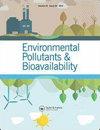Elemental composition of PM10 in indoor environments of a scientific research institution and risk assessment
IF 3.2
4区 环境科学与生态学
Q2 BIOCHEMISTRY & MOLECULAR BIOLOGY
Environmental Pollutants and Bioavailability
Pub Date : 2023-07-03
DOI:10.1080/26395940.2023.2232108
引用次数: 0
Abstract
ABSTRACT Synchronized indoor and outdoor sampling campaigns of PM10 were performed in two research laboratories and a mechanical workshop in Mexico City, during the dry cold season. The goals were to measure indoor and outdoor gravimetric mass and elemental concentrations, recognize the origin of particles, penetration toward the indoor environments, and assess inhalation, ingestion, and dermal absorption risks to human health. Concentrations of 18 elements were measured with X-ray Fluorescence; selected samples were studied with Scanning Electron Microscopy. Mass concentrations were higher outdoors than indoors and elemental concentrations were similar. Enrichment factors identified several geogenic elements. Cluster Analysis recognized common sources of elements and penetration of outdoor particles to indoor environments. Particles emitted indoors could be identified. Exposure to Mn, Fe, Ni, Cu, Zn, and Pb particles produced low health risks; Cr may only cause an ingestion risk. Only outdoor Mn and Ni Hazard Quotients are higher outdoors than indoors.某科研机构室内环境PM10元素组成及风险评价
本文章由计算机程序翻译,如有差异,请以英文原文为准。
求助全文
约1分钟内获得全文
求助全文
来源期刊

Environmental Pollutants and Bioavailability
Chemical Engineering-Chemical Health and Safety
CiteScore
4.30
自引率
3.00%
发文量
47
审稿时长
13 weeks
期刊介绍:
Environmental Pollutants & Bioavailability is a peer-reviewed open access forum for insights on the chemical aspects of pollutants in the environment and biota, and their impacts on the uptake of the substances by living organisms.
Topics include the occurrence, distribution, transport, transformation, transfer, fate, and effects of environmental pollutants, as well as their impact on living organisms. Substances of interests include heavy metals, persistent organic pollutants, and emerging contaminants, such as engineered nanomaterials, as well as pharmaceuticals and personal-care products as pollutants.
 求助内容:
求助内容: 应助结果提醒方式:
应助结果提醒方式:


